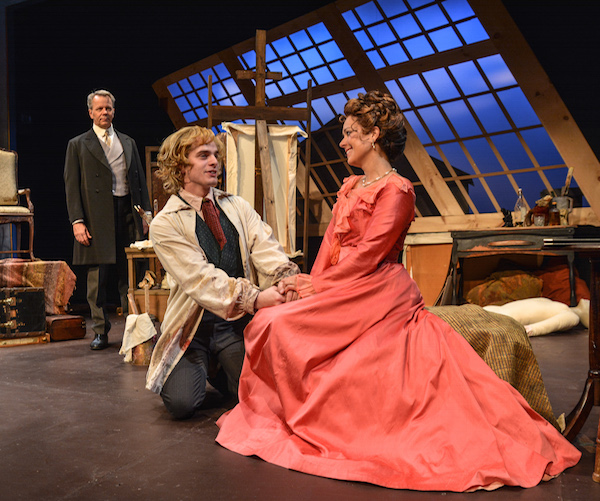Theater Review: “The Doctor’s Dilemma” — Problem Solved
The ethical deliberations and the professional backbiting and banter of the doctors — in the skilled hands of the director and cast — are energized by genuine camaraderie.
The Doctor’s Dilemma by George Bernard Shaw. Directed by Gus Kaikkonen. Staged by the Peterborough Players at 55 Hadley Road in Peterborough, NH, through August 27.

L to R: David Haugen, Will Champion, and Karron Graves in the Peterborough Players production of “The Doctor’s Dilemma.” Photo: Will Howell.
By Jim Kates
For eighty years, George Bernrd Shaw has been the playwright whose well the Peterborough Players have dipped into most often, but never before have they put on his 1906 “problem play,” The Doctor’s Dilemma. There may be a good reason for this. Even Shaw’s most lively and popular plays are known for being talky, but this script is more of a conversational cantata than a drama. Its chatty stiffness presents quite a dilemma for a director.
The director of the Peterborough Players’ production, Gus Kaikkonen, solves this problem by drawing out the contrasting idionsyncratic personalities of the gaggle of medical professionals who gather around a dying patient and his fetching wife to the point that one theatergoer at intermission was heard to remark that all of the consulting doctors were a little bit mad.
I wouldn’t quite say mad, but certainly obsessive. Kaikkonen uses the known strengths of several of the Players’ regular actors very effecitively. Tom Frey has softened a sometimes discordant bellow, coming up with a modulated model of insensitivity; every laugh generated by surgeon Cutler Walpole’s monomania about blood poisoning and targeted surgery is well earned. Kraig Swartz uses his manic energy (a phrase I have overused in describing Swartz’s work over the years, but it remains too accurate to drop) to create a Dr. Ralph Bonington that any member of the audience would willingly throttle, if we could get to him.
Jonathan Hogan is newer to the Players, and his portrayal of the representative of the older generation of medical pratitioners, Sir Patrick Cullen, comes as close as we get to a sane center around which revolves the action and the garrulousness. For him, there is nothing new under the scientific sun, which makes the others seem even more unstable in his presence.
The doctor most starkly faced with the dilemma of the title, however, is Sir Colenzo Ridgeon, whose stodgy confusion when faced with clear medical diagnoses and ambiguous ethical decisions is dramatized through careful understatement by David Haugen. Sir Colenzo has been besieged by the comely, determined, and distraught wife — think of the opening scene of Saint Joan — to take on the case of her dying husband.
And here’s the central dilemma. Sir Colenzo falls in love with the wife, as we all must do with Karron Graves’ accomplished performance. Graves has made Shaw and his contemporaries her own with the Players before, always with spot-on success. Alas, her husband, an artist of real talent with a genuinely threatening disease, turns out to be a moral failure and a social leech. William Champion transforms the bohemian husband, Louis Dubedat, into an almost complete caricature, right down to the artificial make-up that makes the character look too lively to be a consumptive — it made me think of the sinister Joker in Batman comics.
Sir Colenzo’s promise to Mrs. Dubedat is compromised by the doctor’s detestation of her husband and the rather contrived call to devote his healing powers to helping a far more worthy patient, his colleague Dr. Blenkinsop (Cory Buffaloe).
Is a morally reprehensible potentially great artist worth saving all? Does art redeem its creator? If so, should the artist be saved at the expense of sacrificing a truly philanthropic contributor to society?
What does the good doctor do if he deliberately puts his patient in the hands of a colleague he believes to be incompetent?
And what about Mrs. Dubedat and Sir Colenzo’s mixed motivations regarding her?
These are melodramatic questions that could easily bog down a production. They don’t. The ethical deliberations and the professional backbiting and banter of the doctors — in the skilled hands of the director and cast — come across such genuine camaraderie that the patients, and their problems, seem far less relevant than they should be.
One reservation: given all the care lavished on the production, the very last scene almost comes across as a throwaway afterthought. The otherwise delightfully comfortable set design by Charles Morgan gives way to a perfunctory display of incongruous art — impossibly Dubedat’s (if this is meant as a different kind of joke, it falls flat — perhaps the only joke in the whole production that does) and a rather sudden dismissal of the plot, undubitably Shaw’s.
Still, the Peterborough Players’ longtime experience with Shaw shows itself especially valuable in keeping The Doctor’s Dilemma alive. Visiting hours are every evening for the next two weeks.
Jim Kates is a poet, feature journalist and reviewer, literary translator and the president and co-director of Zephyr Press, a non-profit press that focuses on contemporary works in translation from Russia, Eastern Europe, and Asia. His latest book is Muddy River (Carcanet), a translation of verse by Russian existentialist Sergey Stratanovsky. His translation of Mikhail Yeryomin: Selected Poems 1957-2009 (White Pine Press) won the second Cliff Becker Prize in Translation.
Tagged: George-Bernard-Shaw, Gus Kaikkonen, Peterborough Players
